Describing Things ESL Games, Activities & Worksheets
Size, Weight, and Dimensions
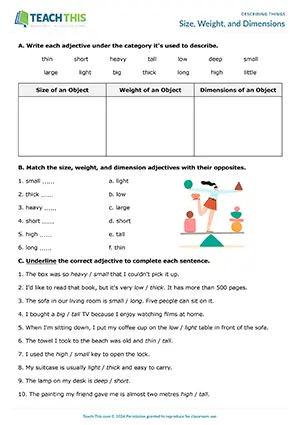
ESL Describing Objects Worksheet - Vocabulary Exercises: Categorising, Matching, Binary Choice, Multiple Choice, Sentence Completion
In this useful describing objects worksheet, students practice adjectives used to describe the size, weight, and dimensions of objects. First, students write...
Describing Things Scramble

ESL Describing Things Game - Reading and Vocabulary: Matching, Forming Descriptions - Pair Work
In this productive describing things game, students race to form descriptions with 'made' or 'used' + preposition expressions. In pairs, students begin by separating cards into three types: sentence beginning...
Made + Preposition
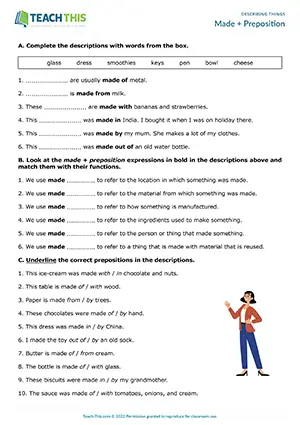
ESL Describing Things Worksheet - Vocabulary Exercises: Gap-fill, Matching, Binary Choice - Speaking Activity: Brainstorming - Pair Work
In this comprehensive describing things worksheet, students learn how to describe things with 'made' + preposition expressions. First, students complete...
Think of Something
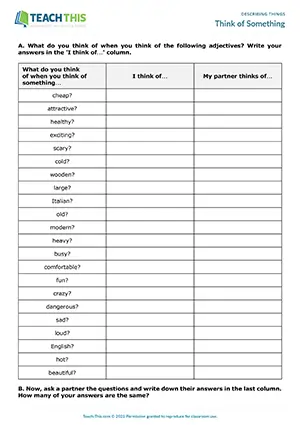
ESL Describing Things Activity - Vocabulary: Word Association - Pair Work
In this intriguing describing things activity, students associate things with adjectives and discuss their answers. Working alone, students read each question, e.g. 'What do you think of when you think of something white?' and write their...
What could it be?
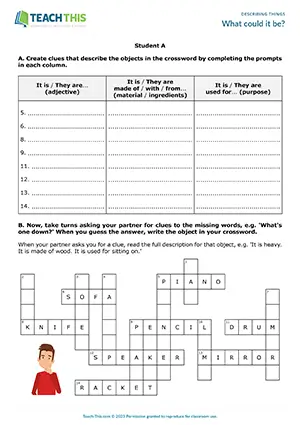
ESL Describing Things Activity - Vocabulary and Speaking: Writing Crossword Clues, Describing, Guessing, Controlled Practice - Pair Work
In this useful describing things crossword activity, students describe and guess everyday objects. In two groups, students invent and write down clues...
Describing Objects

ESL Describing Objects Worksheet - Vocabulary Exercises: Matching, Gap-fill, Writing Descriptions - Speaking Activity: Describing, Guessing - Pair Work
This free describing objects worksheet helps students learn how to describe things using adjectives, the materials they're made of, and their uses. First, students...
Origin

ESL Describing Things Game - Speaking: Describing, Guessing - Pair Work
In this engaging describing things game, students describe things that come from different countries. Each pair is given a set of cards that show things countries are famous for, such as types of food, animals, sports, company names, products...
The Describing Game
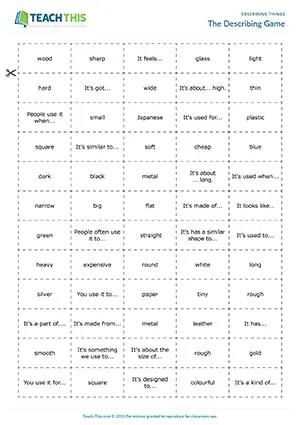
ESL Describing Things Game - Vocabulary: Describing - Group Work
In this creative describing things game, students describe objects with specific adjectives and phrases. In groups, players take turns turning over five cards. The player then thinks of an object and tries to use the five adjectives or phrases...
Whatsitsname?
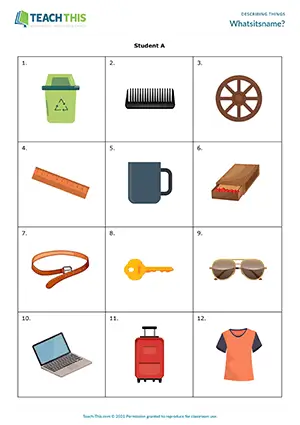
ESL Describing Objects Game - Speaking: Describing, Guessing - Group and Pair Work
In this entertaining describing things guessing game, students describe objects for a partner to guess. In two groups, students discuss and make notes on how to describe the objects on their worksheet without saying what they are. Students then pair up with...
Advertising Products
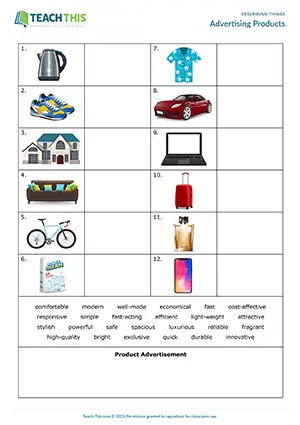
ESL Describing Products Activity - Vocabulary and Writing: Matching, Writing Advertisements, Presenting - Pair Work
In this handy product descriptions activity, students practice adjectives commonly used to advertise products and then use them to write product advertisements. First, in pairs, students look at adjectives...
Ancient Artifacts

ESL Describing Objects Game - Speaking: Describing, Guessing - Group Work
In this interesting describing objects activity, students take on the role of archaeologists in the far future and play a game where they describe objects and guess possible uses. Students imagine that they are archaeologists in the far future and that...
Describe it
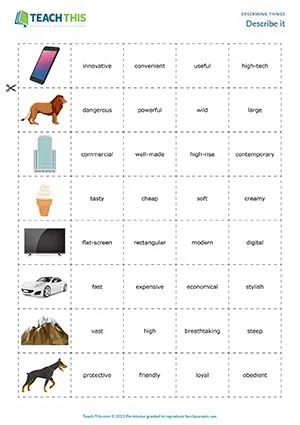
ESL Describing Things Game - Vocabulary: Matching, Forming Sentences - Group Work
In this free describing things game, students match adjectives to pictures and then describe the pictures using the adjectives. The aim of the game is for players to get four adjective cards that describe one of the pictures on the table...
Adjectives of Size, Shape and Colour

ESL Describing Things Worksheet - Vocabulary and Writing Exercises: Matching, Gap-fill, Listing, Writing a Paragraph
In this insightful describing things worksheet, students practice adjectives of size, shape and colour to describe rooms and objects in the home. First, students match adjectives of size, shape and colour...

